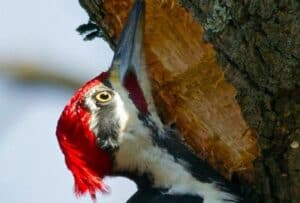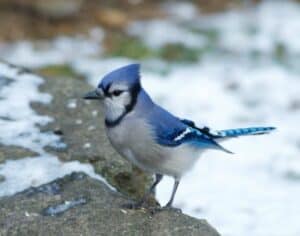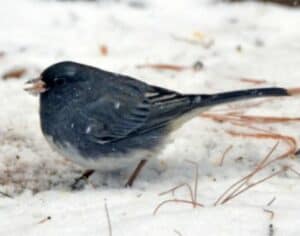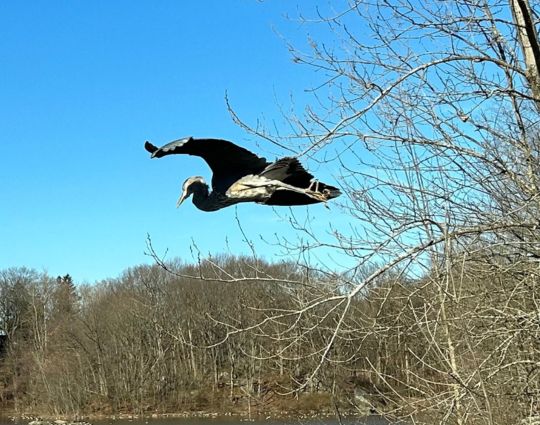When I was a kid, it seemed simple: Birds fly south for the winter to go to a warmer climate. Is that even true anymore? On my recent walk on the trails around our pond, I spotted Mallards, Canada Geese, Mourning Doves, a Great Blue Heron, a pair of Mute Swans, Hooded Mergansers, a Goldeneye, Sparrows, a Carolina Wren, a Pileated Woodpecker, a Hairy Woodpecker, Blue Jays, Robins, and Gulls! What gives??
The issue is food sourcing, not necessarily warmer climates. And birds are complicated—in a good way:
- Some, like the Osprey that live and fish here in the summer, are classic migrators. They make a journey of thousands of miles down to Central and South America for the winter.
- Others, like almost all of our Woodpeckers, stick around as they find plenty of food. They drill into trees for hidden larvae of ants, beetles, and other bugs. We’ve got a program devoted to woodpeckers coming up in March!

- Those Hooded Mergansers that we love seeing as they swim on the pond? They are what are called short-distance migrators. In late fall, they migrate from not too far north of us, moving just ahead of winter ice. The hoodies that we see may have come from upstate New York or Canada. This is their migration endpoint!
- The Great Blue Heron is considered a partial migrator. While those from north and central North America are highly migratory, those from eastern North America are more flexible, with some remaining pretty far north, especially in mild winters. It takes a lot of energy to migrate, and there are many risks along the way. If they successfully make it to the Caribbean, Central America, or northern South America (their migration endpoints), they are pretty much assured of food. However, if the Great Blues stay north, they don’t have to expend any energy on migration. The risk for those who stay is food scarcity; they’re gambling on either a mild enough winter that they can gather food from unfrozen ponds and lakes or catching mice or other small animals when bodies of water are frozen.
- We see and hear (they are noisy!) a lot of Blue Jays because most don’t migrate. But about 20% of them do (are you keeping track, here?). Jays that migrate one year don’t necessarily migrate the next year, and vice versa. Young Blue Jays are more likely to migrate, but adult Blue Jays migrate as well. It’s very individual and varies year to year. Blue Jay migration is still a scientific mystery.

- Most local American Robins don’t migrate; it’s really only Robins in northern Canada that do. We don’t notice the Robins as much in the winter, as they spend more time roosting up in trees and less time on the ground. Maybe that’s because their on-the-ground food sources—a.k.a., worms and bugs—are unavailable in the winter. Instead, they eat berries from shrubs and trees in the winter.
- Our Chickadees are permanent residents. How do these tiny birds survive? They employ many strategies. In terms of food, they are omnivorous, able to take advantage of almost any source of nutrition. They also cache food in the fall for the winter.
For me, bird migration is like almost anything in nature. The more I investigate, the more I learn that things are usually more complex than an either/or situation. In addition, plants and animals seem to be adapting and evolving rapidly these days in response to climate change and habitat loss; because of this, I find that my assumptions about the way nature works are challenged and need to be updated regularly. The good thing is that I get to learn by immersing myself in nature, which is my happy place.
If you’re interested in birds, specifically which birds are in our area at this time of the year, I encourage you to participate in The Great Backyard Bird Count. This annual citizen-science project was started in 1998 by the Cornell Lab of Ornithology and the National Audubon Society (it now also includes the Birds Canada organization) to collect and share data on wild birds. Over four days in February, people spend time watching and counting birds in their area. These worldwide observations help the scientific community better understand global bird populations. 
The Great Backyard Bird Count has so many attributes that make it appealing. It’s family friendly, you can do it anywhere (including your backyard), it’s free, you’re helping scientists and ultimately protecting birds, you get to be outside, and it’s fun! It’s also happening this coming Friday through Monday—get started here. You can also submit your bird (and other wildlife) captures to the Sheldrake Winter Photography Contest!
And the birds that did migrate in late summer and fall? They’ll be back soon, and I hope to be outside in nature to greet them! Stay tuned for an April birding walk at Sheldrake to welcome them home.
Sources:
All About Birds
Heron Conservation
Bird Count
Birds and Blooms

